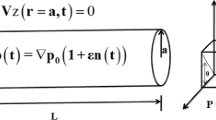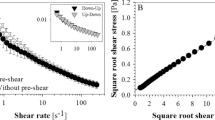Abstract
Human blood at physiological volume concentration exhibits non-Newtonian and thixotropic properties. The blood flow in the microcirculation is pulsatile, initiated from the heart pulse and can be considered as superposition of two partial flows: a) a steady shear, and b) an oscillatory shear. Until now steady and viscoelastic behavior were separately investigated. Here we present the response to the combination of steady and oscillatory shear for human blood, a high molecular weight aqueous polymer solution (polyacrylamide AP 273E) and an aqueous xanthan gum solution. The polyacrylamide and xanthan solutions are fluids that model the rheological properties of human blood. In general, parameters describing blood viscoelasticity became less pronounced as superimposed steady shear increased, especially at low shear region and by elasticity, associated with reduction in RBC aggregation. The response of polymer solutions to superposition shows qualitative similarities with blood by elasticity, but their quantitative response differed from that of blood. By viscosity another behavior was observed. The superposition effect on viscous component was described by a modified Carreau equation and for the elastic component by an exponential equation.
Similar content being viewed by others
References
Argumedo A, Tung TT, Chang KI (1978) Rheological property measurements of drag-reducing polyacrylamide solutions. J Rheol 22:449–470
Barnes HA, Townsend P, Walters K (1971) On pulsatile flow of non-Newtonian fluids. Rheol Acta 10:517–527
Booji HC (1966a) Influence of superimposed steady shear flow on the dynamic properties of non-Newtonian fluids. I. Measurements of non-Newtonian solutions. Rheol Acta 5:215–221
Booji HC (1966b) Influence of superimposed steady shear flow on the dynamic properties of non-Newtonian fluids. II. Theoretical approach based on the Oldroyd theory. Rheol Acta 5:222–227
Booji HC (1968) Influence of superimposed steady shear flow on the dynamic properties of non-Newtonian fluids. III. Measurements on oscillatory normal stress components. Rheol Acta 7:202–207
Brookshier KA, Tarbell JM (1993) Evaluation of a transparent blood analog fluid: Aqueous xanthan gum/glycerin. Biorheology 30:107–116
Carreau PJ (1972) Rheological equations from molecular network theories. Trans Soc Rheol 16:99–127
Chien S (1970) Shear dependence of effective cell volume as determinant of blood viscosity. Science 168:977–979
Chien S, Usami S, Dellenback RJ, Gregersen MI (1967a) Blood viscosity: Influence of erythrocyte deformation. Science 157:827–829
Chien S, Usami S, Dellenback RJ, Gregersen MI, Nanninga LB, Guest MM (1967b) Blood viscosity: Influence of erythrocyte aggregation. Science 157:829–831
Chien S, King RG, Skalak R, Usami S, Copley AL (1975) Viscoelastic properties of human blood and red cell suspensions. Biorheology 12:341–346
Cokelet GR (1987) The rheology and tube flow of blood. In: Skalak R, Chien S (eds) Handbook of Bioengineering. McGraw-Hill, pp 14.1–14.17
Copley AL, King RG (1975) On the viscoelasticity of anticoagulated wheol human blood in steady shear as tested by rheogoniometric measurements of normal forces. Biorheology 12:5–10
De Cleyn G, Mewis J (1981) A constitutive equation for polymer liquids: Application to shear flow. J Non-Newtonian Fluid Mech 9:91–105
Easthope PL, Brooks DE (1980) A comparison of theological constitutive functions for whole human blood. Biorheology 17:235–247
Fukada E, Seaman GVF, Liepsch D, Lee M, Friis-Baastad L (1989) Blood modeling using polystyrene microspheres. Biorheology 26:401–413
Gaethgens P (1970) Pulsatile pressure and flow in the mesenteric vascular bed of the cat. Pflügers Arch 316:140–151
Graessley WW (1974) The entanglement concept in polymer rheology. Adv Polym Sci 16:1–179
Intaglietta M, Richardson DR, Tompkins WR (1971) Blood pressure, flow, and elastic properties in microvessels of cat omenturn. Am J Physiol 221:922–928
Isayev AI, Wong CM (1988) Parallel superposition of small- and large-amplitude oscillations upon steady shear flow of polymer fluids. J Polym Sci Pol Phys 26:2303–2327
Jones TER, Walters K (1971) The behaviour of materials under combined steady and oscillatory shear. J Phys A Gen Phys 4:85–100
Kiesewetter H, Radtke H, Jung F, Schmid-Schönbein H, Wortberg G (1982) Determination of yield point: Methods and review. Biorheology 19:363–374
Ku DN, Liepsch D (1986) The effects of non-Newtonian viscoelasticity and wall elasticity at a 90° bifurcation. Biorheology 23:359–370
Laufer Z, Jalink HL, Staverman AJ (1975) Dynamic properties of some polymer solutions subjected to a steady shear superimposed on an oscillatory shear flow. I. Experimental results. Rheol Acta 14:641–649
Lerche D, Baumler H, Kucera W, Meier W, Paulitschke M (1991) Flow properties of blood and hemorheological methods of quantification. In: Schütt W, Klinkmann H, Lamprecht I, Wilson T (eds) Physical characterization of biological cells. Verlag Gesundheit GmbH, Berlin, pp 189–214
Lerche D, Vlastos G, Koch B, Pohl M, Affeld K (1993a) Viscoelastic behaviour of human blood and polyacrylamide model fluids for heart valve testing. J Phys III France 3:1283–1289
Lerche D, Koch B, Vlastos G (1993b) Flow behaviour of blood. Rheology 3:105–112
Lessner A, Zahavi J, Silberberg A, Frei EH, Dreyfus F (1971) The viscoelastic properties of human blood. In: Hartert H, Copley AL (eds) Theoretical and Clinical Hemorheology. Springer, Berlin, pp 194–205
Liepsch D (ed) Biofluid Mechanics. Blood flow in large vessels. Springer Verlag
Lim T, Uhl IT, Prud'homme RK (1984) Rheology of self-associating concentrated xanthan solutions. J Rheol 28:367–379
Malkin AY, Isayev AI, Vinogradov GV (1975) Power estimate of the effectiveness of vibrational thinning of polymer and filled systems. Polym Mech USSR 11:439–444
Mann DE, Tarbell JM (1990) Flow of non-Newtonian blood analogs fluids in rigid curved and straight artery models. Biorheology 27:711–733
Masi P, Nicodemo L, Nicolais L, Taglialatela G (1984) Viscosity of glass bead suspensions in parallel superimposed flows. Rheol Acta 23:324–326
Mewis J, Schoukens G (1978) Mechanical spectroscopy of colloidal dispersions. Faraday Discuss 65:58–64
Oka S (1981) Cardiovascular hemorheology. Cambridge University Press
Osaki K, Tamura M, Kurata M, Kotaka T (1965) Complex modulus of concentrated polymer solutions in steady shear. J Phys Chem 69:4183–4191
Pipkin AC, Owen DR (1967) Nearly viscometric flows. Phys Fluids 10:836–843
Pohl M, Wendt MO, Werner S, Koch B, Lerche D (1996) In vitro testing of artificial heart valves: Comparison between Newtonian and non-Newtonian fluids. Artif Organs 20:37–46
Riha P, Stolz JF (1996) Flow oscillations as a natural factor of reduction of the effect of RBC aggregation on blood flow. Clin Hemorheol 16:43–48
Rochefort WE, Middleman S (1987) Rheology of xanthan gum: Salt, temperature, and strain effects in oscillatory and steady shear experiments. J Rheol 31:337–369
Schmid-Schönbein H (1981) Blood theology and physiology of microcirculation. La Ricerca Clin Lab 11:13–33
Tanner RI, Simmons JM (1967) Combined simple and sinusoidal shearing in elastic liquids. Chem Eng Sci 22:1803–1815
Tanner RI, Williams GW (1971) On the orthogonal superposition of simple shearing and small-strain oscillatory motions. Rheol Acta 10:528–538
Thurston GB (1972) Viscoelasticity of human blood. Biophys J 12:1205–1217
Thurston GB (1975) Elastic effects in pulsatile blood flow. Microvasc Res 9:145–157
Thurston GB (1994) Non-Newtonian viscosity of human blood: Flow-induced changes in microstructure. Biorheology 31:179–192
Thurston GB, Pope GA (1981) Shear rate dependence of the viscoelasticity of polymer solutions. II. Xanthan gum. J Non-Newtonian Fluid Mech 9:69–78
Usami S (1982) Physiological significance of blood rheology. Biorheology 19:29–46
Vlassopoulos D, Schowalter WR (1993) Characterization of the non-Newtonian flow behavior of drag-reducing fluids. J Non-Newtonian Fluid Mech 49:205–250
Vlassopoulos D, Schowalter WR (1994) Steady viscometric properties and characterization of dilute drag-reducing polymer solutions. J Rheol 38:1427–1446
Vlastos G, Koch B, Lerche D, Pohl M (1992) Polymer solutions as model fluids for the non-Newtonian behaviour of blood. In: Moldenaers P, Keunings R (eds) Theoretical and Applied Rheology, Vol. 2. Elsevier, Amsterdam, pp 747–749
Vlastos G, Lerche D, Koch B (1994) Viscoelastic behaviour of human blood and blood-like model fluids with emphasis on low oscillatory shear rates. In: Gallegos C (ed) Progress and Trends in Rheology IV. Steinkopff Verlag, Darmstadt, pp 32–34
Wells R, Schmid-Schönbein H (1969) Red cell deformability and fluidity of concentrated cell suspensions. J Appl Physiol 27:213–217
Whitcomb PJ, Macosko CW (1978) Rheology of xanthan gum. J Rheol 22:493–505
Author information
Authors and Affiliations
Corresponding author
Rights and permissions
About this article
Cite this article
Vlastos, G., Lerche, D., Koch, B. et al. The effect of parallel combined steady and oscillatory shear flows on blood and polymer solutions. Rheola Acta 36, 160–172 (1997). https://doi.org/10.1007/BF00366822
Received:
Accepted:
Issue Date:
DOI: https://doi.org/10.1007/BF00366822




